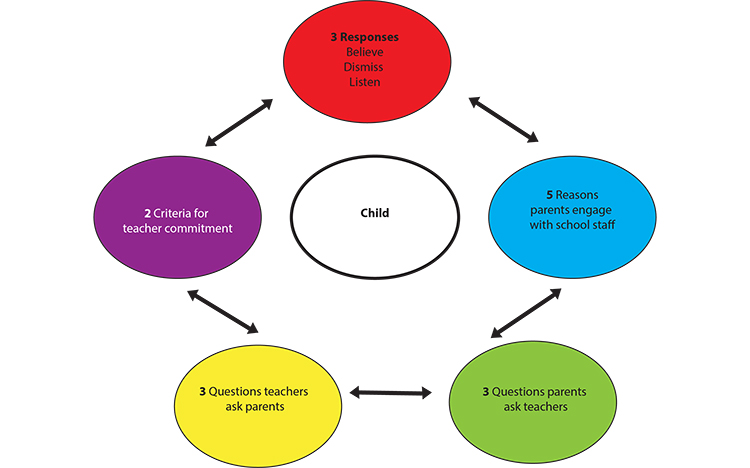3 + 3 + 3 + 5 + 2 - A formula for trust and collaboration

When a child comes home from school and shares their recollection about something that has happened during the day, the parent has the choice of three responses from which they may choose in dealing with their child’s concern. If the parent believes what their child has said is 100% accurate and factual, AND they are not happy about that, then the parent has some options.
The first option might be to ring, email or contact the school staff and “explode”. Not preferable but not uncommon. This will not build a relationship between the school and the parents. In fact it will break down the relationship.
The second option is for the parents to say to the child “Thanks very much I believe your story but toughen up, grow up and be more resilient”. This in effect is brushing the child aside. They're not giving them the support and empowerment that they need and deserve. The third option is for the parents to listen to the child cautiously and then choose one of three responses, and then one of three questions which they should ask the school staff.
The first question is simply to say to the school staff when they have the opportunity – “What happened at school?” regarding this particular matter. They would report what their child has said about the incident and they then give the school staff the opportunity to respond. This simply allows the staff to reflect on their knowledge of the intent without getting defensive. They are simply sharing information with the parents. At that point the parents will reflect as to the accuracy of both stories so that they can move forward and in supporting their child.
The second question the parents may choose to use is – “What is the school's policy or protocols or procedures regarding…… (whatever)?” For example if a child comes home with an injury and the parents were not notified before the child got home and that caused distress for the parents, they may simply contact the school and ask very politely and calmly what is the schools policy and protocols and procedures for notifying parents regarding injuries? With that information they are in a position to judge whether or not the school followed the process and protocols or whether or not the school has let them down.
The third question at the parents may choose to use is “What can we as parents and teachers do in working together for my child's education?” This highlights the need for collaboration. It highlights the importance of the parents and teachers working together and providing a common vision of education for the children.

Figure 1: Trust model parents and teachers
When a parent comes and expresses some concerns to a teacher, the teacher can easily get defensive. If we are in a position to build a culture of trust and collaboration between parents and teachers, then I believe there are only three questions that teachers need to ask parents in response to any of the concerns.
The first question is simply “What do you need?” This means that the parents need to reflect upon the purpose as to why they are coming and having a conversation with the teacher and what they hope to achieve by having a conversation. So, by the teacher asking the question: what do you need? the parent sits back and reflects and thinks “Am I here to share information?” Or am I here because I want a resolution to a problem? Or am I here because I want some advice and I hope the teacher can give me some advice about a particular issue. Or am I here simply to gather information and a better understanding about what's happening in the school. As soon as the teacher asks the question “What do you need?” they are in fact responding to the importance of the parent's query. This adds value to the parents question and hence the parent feels that they are important and that you are validating their query and it and will be addressed.
The second question that teachers could ask parents when they come for an interview or meeting is “What do you imagine that would look like in our classroom or in our school?” So, when a parent comes and asks for a request for something to be achieved or something to be done, when the teacher asks the parent “What you think that would look like?” It puts the emphasis back on the parent to try articulate the practical application for their query to be implemented in the classroom or school setting. When the question is asked, parents are often able to sit back and think what they're asking may not be practical, it may not be sustainable, it may not be possible to impose something on the teachers. A lightbulb moment may occur and the parents may then re-frame their query or question to be more practical and realistic.
The third question that teachers can ask parents is “Is there anything else you'd like to ask or say or tell me before we close the meeting?” This simply gives the parents the chance to reflect and to ensure that their needs have been met and both parties can walk away content that they have been heard. So it's a simple technique which allows teachers to close off the conversation. It also allows the parents some closure. They have had the opportunity to express their concerns, and had the opportunity to be heard. There may be a resolution which meets their needs and if there's not, then parents may choose to take their concerns further, to a member of the school’s Leadership Team. Hopefully the same pattern of questioning can be employed.
Let me restate those three questions that teachers can ask parents to again create a culture of trust in collaboration between teachers and parents. Question number one: “What do you need?” Question number two: “What you think that would look like in our classroom or school setting?” Question number three: “Is there anything else you'd like to ask me or tell me or say before we conclude?”
Parents now have these questions, so when you visit a school to make an enquiry, you can re-frame your questions around this model even if the teachers don’t use the questions to direct your conversation.
When a parent goes to their child’s school they usually approach the teachers or the principal for one of five reasons. Once they are asked “What do you need?” it helps them reflect on why they have gone to the school.
The first reason why parents go to school is to simply share information, good or bad. It might be to give information, to give praise or simply to get something off their chest, to express their opinion and once they have expressed their concerns about whatever, they're happy. This the first reason for engaging with schools.
The second reason parents may come to a school is to seek information, context or history. They just want to understand the history so that they get a better grasp of why the system exists and how long the system has existed. They are just seeking information, context or history.
The third reason parents may go to school to talk to the principal or a teacher may be to offer a solution. Parents may have expertise in a field that may add value to the school. The principal often calls upon parent expertise in an advisory capacity. This model is relevant when parents have a particular skills set that can benefit the school community. It is also a reason why parents may be invited to join School Boards, as they bring expertise to the table.
The fourth reason may be that the parents are asking the school for a resolution or a solution to the particular issue. If the processes are reviewed and can be improved then a solution may be possible. Solutions are not always possible or resolutions may not always give the parents their desired outcome. It is important to remember that principals and school leaders make decisions in the best interests of all (or the majority) of families and students. The principal also has the ‘big picture’ in mind, whereas the parents only have to worry about their children. This is seeking a resolution or a solution to their particular problem.
Similar to the fourth reason is the final reason parents may engage with schools – and that is to seek advice from staff. This model requires the parents to own the implementation of the advice. This highlights collaboration as the parents request advice from the staff, and then the parents have to act on it.
Let me go over those five reasons why parents come to school to engage with the staff. One – they're coming to share information, good or bad. Two – they're coming to seek information, context or history as to why something already exists. Three – they're coming to offer a suggestion or solution and to support the school in its endeavours. Four – they're coming for a resolution or solution to a problem. And finally five – parents come and seek some advice about how they can solve a problem.
I would encourage teachers and principals to simply ask the question what does the parent need when they come in to have a conversation with a member of staff. Once the parent can articulate what they need then the teacher or the principal is in the position to understand the rationale for visiting and hence can tailor their response to meet the parents’ needs understand the context as to why they're there. It's not easy but it's worth the journey. Good luck!
When teachers respond to any parent request the teacher should filter their response with these two criteria: is the response SUSTAINABLE and REALISTIC. If the teacher’s response meets these criteria then it may be a viable option. If the response desired by the parents from the teacher does not meet these criteria then it would be advisable to re-think the options. It may be necessary to revisit the first question from teacher to parents – what do you need? This may prompt the parents to re-think their desired outcomes.
The formula for building a culture of TRUST and Collaboration is 3 + 3 + 3 + 5 + 2.
Image by Alexandr Podvalny from Pexels